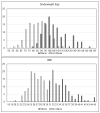Pulmonary Vein Isolation in Obese Compared to Non-Obese Patients: Real-Life Experience from a Large Tertiary Center
- PMID: 36005439
- PMCID: PMC9409713
- DOI: 10.3390/jcdd9080275
Pulmonary Vein Isolation in Obese Compared to Non-Obese Patients: Real-Life Experience from a Large Tertiary Center
Abstract
1. Introduction: Pulmonary vein isolation (PVI) is an established procedure used to achieve rhythm control in atrial fibrillation (AF). In obese patients (pts), in whom AF occurs more frequently, a reduced effectiveness of PVI has been observed. Therefore, this study’s aim was to compare the long-term efficacy of PVI between obese and non-obese patients. 2. Methods: We enrolled 111 consecutive pts with a body mass index (BMI) of >30 kg/m2 undergoing PVI from our large registry. Procedural data and outcomes were compared with a matched group of 115 non-obese PVI pts and the long-term outcomes were analyzed. 3. Results: Overall follow-up duration was 314 patient-years in the obese and 378 patient-years in the non-obese group. The follow-up rate was 71% in the obese and 76% in the non-obese group. In both groups, their AF-characteristics did not differ significantly, while known risk factors were significantly more prevalent in the obese group. Procedural characteristics were similar in both groups. During follow-up, the obese pts demonstrated significant weight loss compared to the non-obese pts, while at the same time, the overall recurrence rate during follow-up did not differ significantly between both groups (obese: 39.2% and non-obese: 43.7%). PVI related and long-term complications were comparable between both groups. In the univariate analysis, obesity was not found to be associated with an increased AF recurrence risk. 4. Conclusion: These real-life data demonstrate that obese pts may not show higher AF recurrence rates after PVI compared to pts with normal body weight. Furthermore, PVI was found to be safe and effective in obese patients; thus, a BMI alone may not be a criterion for refusal of PVI.
Keywords: atrial fibrillation; obesity; pulmonary vein isolation; risk factors.
Conflict of interest statement
The authors report no relationships that could be construed as a conflict of interest.
Figures
Similar articles
-
Left atrial function in obese and non-obese patients undergoing percutaneous pulmonary vein isolation.Heart Vessels. 2019 Feb;34(2):343-351. doi: 10.1007/s00380-018-1243-0. Epub 2018 Aug 24. Heart Vessels. 2019. PMID: 30143884 Free PMC article.
-
Pulmonary vein isolation with the cryoballoon in obese atrial fibrillation patients - Does weight have an impact on procedural parameters and clinical outcome?Int J Cardiol. 2020 Oct 1;316:137-142. doi: 10.1016/j.ijcard.2020.06.001. Epub 2020 Jun 6. Int J Cardiol. 2020. PMID: 32522675
-
Fast atrial activity predicts recurrence of atrial fibrillation after pulmonary vein isolation: results from a prospective randomized study.J Interv Card Electrophysiol. 2015 Mar;42(2):101-6. doi: 10.1007/s10840-014-9962-3. Epub 2015 Jan 16. J Interv Card Electrophysiol. 2015. PMID: 25591723 Clinical Trial.
-
Focal impulse and rotor modulation guided ablation versus pulmonary vein isolation for atrial fibrillation: A meta-analysis of head-to-head comparative studies.J Cardiovasc Electrophysiol. 2021 Jul;32(7):1822-1832. doi: 10.1111/jce.15036. Epub 2021 May 27. J Cardiovasc Electrophysiol. 2021. PMID: 33844385
-
Cavotricuspid isthmus line in patients undergoing catheter ablation of atrial fibrillation with or without history of typical atrial flutter: A meta-analysis.J Cardiovasc Electrophysiol. 2020 Aug;31(8):1987-1995. doi: 10.1111/jce.14614. Epub 2020 Jul 7. J Cardiovasc Electrophysiol. 2020. PMID: 32530541
Cited by
-
Cryoballoon pulmonary vein isolation for atrial fibrillation in obese patients: A non-inferiority analysis.Int J Cardiol Heart Vasc. 2023 Jul 20;47:101244. doi: 10.1016/j.ijcha.2023.101244. eCollection 2023 Aug. Int J Cardiol Heart Vasc. 2023. PMID: 37576082 Free PMC article.
-
New Perspectives on Risk Stratification and Treatment in Patients with Atrial Fibrillation: An Analysis of Recent Contributions on the Journal of Cardiovascular Disease and Development.J Cardiovasc Dev Dis. 2023 Feb 2;10(2):61. doi: 10.3390/jcdd10020061. J Cardiovasc Dev Dis. 2023. PMID: 36826557 Free PMC article.
-
Cryoballoon Pulmonary Vein Isolation in Obese Patients with Atrial Fibrillation Compared to Non-Obese Counterparts: A Meta-Analysis.Biomedicines. 2025 Jan 25;13(2):298. doi: 10.3390/biomedicines13020298. Biomedicines. 2025. PMID: 40002711 Free PMC article. Review.
-
Impact of overweight and obesity on radiation dose and outcome in patients undergoing pulmonary vein isolation by cryoballoon and pulsed field ablation.Int J Cardiol Heart Vasc. 2024 Oct 1;55:101516. doi: 10.1016/j.ijcha.2024.101516. eCollection 2024 Dec. Int J Cardiol Heart Vasc. 2024. PMID: 39403597 Free PMC article.
-
Sex differences in overweight and obese patients undergoing high-power short-duration pulmonary vein isolation for atrial fibrillation: an observational cohort study.Sci Rep. 2024 Nov 14;14(1):28053. doi: 10.1038/s41598-024-78730-7. Sci Rep. 2024. PMID: 39543134 Free PMC article.
References
-
- Hindricks G., Potpara T., Dagres N., Arbelo E., Bax J.J., Blomström-Lundqvist C., Watkins C.L. 2020 ESC Guidelines for the diagnosis and management of atrial fibrillation developed in collaboration with the European Association for Cardio-Thoracic Surgery (EACTS) Eur. Heart J. 2021;42:373–498. doi: 10.1093/eurheartj/ehaa612. - DOI - PubMed
LinkOut - more resources
Full Text Sources


